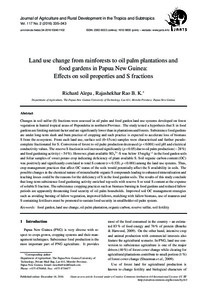Land use change from rainforests to oil palm plantations and food gardens in Papua New Guinea: Effects on soil properties and S fractions
| dc.date.accessioned | 2016-12-15T08:04:55Z | |
| dc.date.available | 2016-12-15T08:04:55Z | |
| dc.date.issued | 2016-12-14 | |
| dc.identifier.issn | 1612-9830 | |
| dc.identifier.issn | 2363-6033 | |
| dc.identifier.uri | urn:nbn:de:hebis:34-2016102451102 | |
| dc.identifier.uri | http://hdl.handle.net/123456789/2016102451102 | |
| dc.language.iso | eng | |
| dc.publisher | Kassel University Press | ger |
| dc.rights | Urheberrechtlich geschützt | |
| dc.rights.uri | https://rightsstatements.org/page/InC/1.0/ | |
| dc.subject | food garden | eng |
| dc.subject | land use change | eng |
| dc.subject | oil palm plantation | eng |
| dc.subject | organic carbon | eng |
| dc.subject | reserve sulfur | eng |
| dc.subject | soil fertility | eng |
| dc.subject.ddc | 630 | |
| dc.title | Land use change from rainforests to oil palm plantations and food gardens in Papua New Guinea: Effects on soil properties and S fractions | eng |
| dc.type | Aufsatz | |
| dcterms.abstract | Changes in soil sulfur (S) fractions were assessed in oil palm and food garden land use systems developed on forest vegetation in humid tropical areas of Popondetta in northern Province. The study tested a hypothesis that S in food gardens are limiting nutrient factor and are significantly lower than in plantations and forests. Subsistence food gardens are under long-term slash and burn practice of cropping and such practice is expected to accelerate loss of biomass S from the ecosystem. From each land use, surface soil (0–15 cm) samples were characterised and further pseudocomplete fractionated for S. Conversion of forest to oil palm production decreased (p<0.001) soil pH and electrical conductivity values. The reserve S fraction in soil increased significantly (p<0.05) due to oil palm production ( 28 %) and food gardening activity (∼ 54 %). However, plant available SO42--S was below 15 mg kg^(−1) in the food garden soils and foliar samples of sweet potato crop indicating deficiency of plant available S. Soil organic carbon content (OC) was positively and significantly correlated to total S content (r=0.533; p<0.001) among the land use systems. Thus, crop management practices that affect OC status of the soils would potentially affect the S availability in soils. The possible changes in the chemical nature of mineralisable organic S compounds leading to enhanced mineralisation and leaching losses could be the reasons for the deficiency of S in the food garden soils. The results of this study conclude that long-term subsistence food gardening activity enriched top soils with reserve S or total S content at the expense of soluble S fraction. The subsistence cropping practices such as biomass burning in food gardens and reduced fallow periods are apparently threatening food security of oil palm households. Improved soil OC management strategies such as avoiding burning of fallow vegetation, improved fallows, mulching with fallow biomass, use of manures and S containing fertilisers must be promoted to sustain food security in smallholder oil palm system. | eng |
| dcterms.accessRights | open access | |
| dcterms.bibliographicCitation | In: Journal of Agriculture and Rural Development in the Tropics and Subtropics. Kassel : Kassel University Press. - Vol. 117, No. 2 (2016), S. 335-343 | |
| dcterms.creator | Alepa, Richard | |
| dcterms.creator | Rajashekhar Rao, B. K. | |
| dc.description.everything | Gedruckte Ausg. im Verlag Kassel Univ. Press (www.upress.uni-kassel.de) erschienen. | ger |
Dateien zu dieser Ressource
Das Dokument erscheint in:
-
Vol 117, No 2 (2016) [13]

